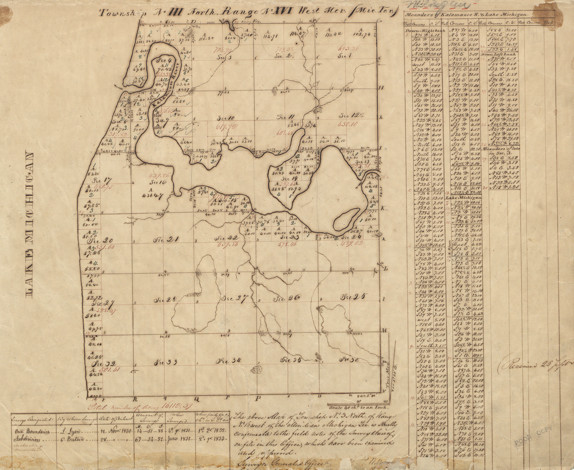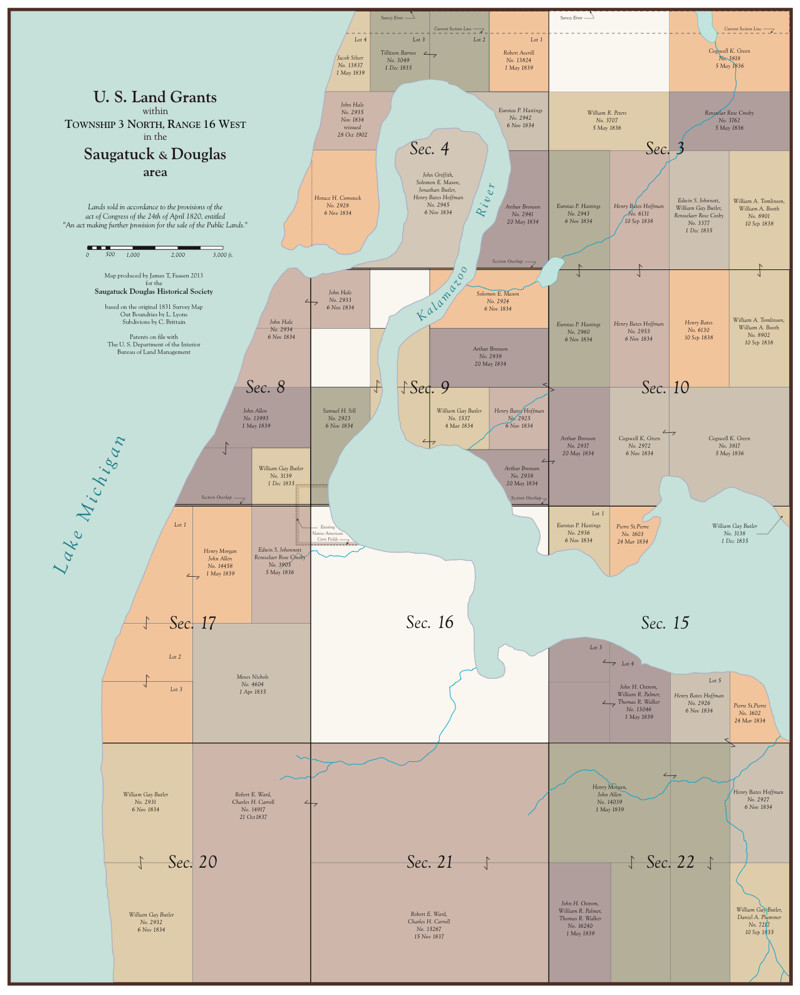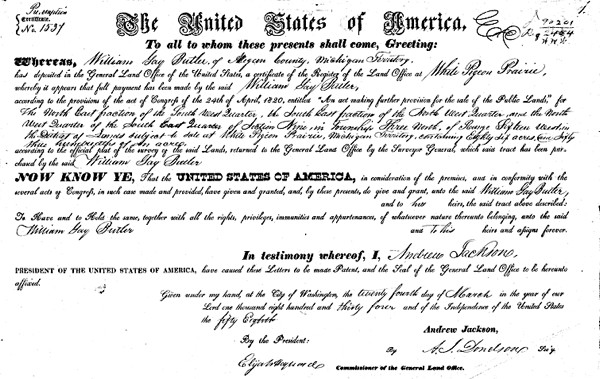
The
native Potawatomi Indians of Michigan ceded nearly all the land south
of Grand river and west of the principal meridian to the United States
by the 1821 Treaty of Chicago.
This treaty did give the exception, among others, for "One tract at the
village the Match-be-barh-she-wish, at the head of the Kekalamazoo
river," which is assumed to be Section 16, the future location of
Douglas and thus the reason there are no Land Grants in Section 16.
William Gay Butler (1799-1857),
the first settlers in the area, came to the mouth of the Kalamazoo
river and located his homestead in the fall of 1829 in Section 9.
With the help of Lucius A. Barnes (1808-1890), a clerk for Indian trader
Louis Campau (1791-1871),
Butler built his house, a 14'x18' log cabin about 495 feet from the
river at about what is now the northwest corner Butler and Mason streets
in Saugatuck, or about the present location of the Roda Building.
However, at that time, Mr. Butler would have been technically considered
a squatter.
Lands in the Territory of Michigan could not be placed on sale until after the completion of the official survey.
The area we now call Saugatuck was first officially surveyed in 1831 by Lucius Lyon (1800-1851), the future Senator from Michigan, with subdivisions by Calvin Brittain (1800-1862), the future Lieutenant Governor of Michigan.
According to the book 'History of Allegan County'
by Dr. Henry F. Thomas,
"From 1831 to 1834 the land office for southwest Michigan was located at
White Pigeon in St. Joseph county, to which point all those buying
lands during those years had to go to make their payments and obtain
legal title to their pre emptions.
After 1834 the Allegan county settlers entered their lands at Kalamazoo
where the land office for this part of the state was continued until
1858.
The United States law required that every piece of land should be put up
at auction after which if not bid off it was subject to private entry
at one dollar and a quarter per acre.
It was an unwritten law among the settlers that each pre emptor should
have the privilege of making the only bid on his land.
This right was universally respected among the settlers no one bidding
on another's claim.
It occasionally happened however that an eastern man unaccustomed to the
ways of the west essayed to bid on the home of a settler, but was soon
convinced in frontier fashion that such action was a distinct
contravention of western custom.
The land speculator in particular was persona non grata with the
settlers and in some parts of the country associations known as
squatters unions were formed to protect the settler in his claims and
when necessary to use force in compelling the speculator to desist from
his sharp practices.
It was owing to the fact that the public auction of land enabled the
speculator to bid in as virgin soil and at the usual price of a dollar
and a quarter an acre lands that had been settled and improved by an
industrious pioneer that the system of public sales was finally
abolished."


The
example on the left shows a scaled down version of one of the images of
the land grants available through the Bureau of Land Management web
site.
The images are all about 2390 by 1520 pixels and are in pdf form and on
average are about 260 kb.
This example is the land grant issued to William Gay Butler
for the lands in Section 9 that would become the Kalamazoo plat of what
was first called Kalamazoo, then changed in 1835 to Newark, and then
finally called Saugatuck.
The number at the top left, 1537
is the document number. These numbers are referenced on the above map
and can be used at the BLM site to look up a specific Land Grant.
Arthur Bronson (1801-1844),
another early land owner, was
a New York City financier who speculated in lands in Illinois,
Wisconsin, Indiana, and Michigan.
He came to Chicago for the first time in the winter of 1832-1833 from
New York and soon was in contact with other leading businessmen and
local land-owners.
He along with his father, Isaac, were instrumental in the creation of
both the New York and Ohio Life Insurance and Trust Companies.
His land deeds in Allegan county all state he was from New York City,
thus a true land speculator with no ties to the area.
Arthur Bronson died of pneumonia on 19 Nov 1844.
A name well known in Saugatuck and St. Joseph was Col Henry Bates Hoffman (1805-1889),
who among other holdings owned the land known as Morrison's addition and
Resort addition east to N. Maple .St to include what is called John
Francis land on the 1913 map.
It is assumed that this is the Mr. Hoffman from St. Joseph stated in the
Butler letters, but in 1834 Henry B. Hoffman was from Berrien County,
the son of Col. William and Catherine (Driscoll) Hoffman (1783-1873)
and the brother of George W. Hoffman (1809-1886) of St. Joseph and would also be the brother of General William Hoffman Jr (1807-1884) classmate of Robert E. Lee.
In the 1830 census, Henry B. Hoffman would be in Mackinac Island and by a short bio of his brother George W. Hoffman in "A Twentieth Century History of Berrien county, Michigan,"
in 1831 Henry B Hoffman engaged in the mercantile business in Mackinac
then removed to Niles and went into partnership with his brother,
George W. Hoffman.
In 1853, Henry B. Hoffman removed to Davenport, Iowa and George went to
Detroit in 1857 where he died a few years since.
The Hoffman family was a military one connected with the regular army.
The father Major William Hoffman made his home at Niles after 1839.
He was a major in the United States army during the Florida war. He died
at Corpus Christi during service in the Mexican war.
His son Satterlee Hoffman was also in the Mexican war and was killed at
the battle of Cherubusco.
Col. Hoffman was a gentleman of the old school. He and his brother,
George Hoffman, laid out several additions to Niles. Niles Daily Star,
Wednesday, March 27, 1889, page 3, col. 2, microfilm Niles District
Library Henry B. Hoffman, Esq., one of the early settlers of Niles, and
for many years one of our most respected citizens, died at Davenport,
Iowa, on the 21st Inst. Several of the additions to the city of Niles
bear his name.
Then
there is the sad case of Solomon E. Mason, of St. Joseph, who
tragically died in early Sep 1834 before his land grants were issued in
Washington D. C. on 6 Nov 1834. Mason Street in downtown Saugatuck is
named after him.
The Corrector
Sag Harbor, NY
September 20, 1834
Melancholy
Accident. - We learn with sorrow that the schr, Postboy, while on her
passage from Chicago to Buffalo, was capsized near the Manitou Islands,
and all on board except the captain and mate, drowned. Among those who
were lost was Mr. Solomon E. Mason, of St. Joseph.
Detroit Courier.
New York Evening Post
unknown date in 1834 late August or early September
AFFLICTING
PROVIDENCE. - By a letter from St. Joseph, we have the pariculars of
the disaster which recently befell the schooner PostBoy, and the loss of
four persons.
One of the individuals who has thus met an untimely fate is Mr. Solomon
E. Mason, of St. Joseph, and formerly of this city.
Mr. M. was personally known to many of our readers, and the pain and
regret manifested by the loss of os valuable a citizen a d friend,
bespeak for his virtues the most lively recollection.
-- Detroit Free Press.
ST.
JOSEPH, Aug. 25. -- The schooner Post Boy left this port on the 10th
inst., having on board Mr. S. E. Mason, and Robert Deacon,
captain, mate, and two hands. When near the Manitou Island, about 70
mile, from Mackinac, the schooner was struck by a ___ of wind and
capsized. At this time (about 10 o'clock in the evening) Mr. Mason and
one of the bands were asleep in the cabin, and it is supposed were
corwned immediately.
The captain, mate, Mr. Deacon, and a sailor stock to the vessel for
twenty boors, during which time it drifted aground. The four ___, cut
away the main boom and aitempted to make the shore upon it.
The captain and mate succeeded: Mr. Deacon and the sailor, overcome by
fatigue and exhaustion, were lost. "Two vessels have gone to the wreck."
Research by James T. Faasen 2013
Related references
History of Allegan and Barry counties, Michigan 1880

SAUGATUCK-DOUGLAS HISTORICAL SOCIETY | BOX 617 | DOUGLAS, MI 49406 | 269-857-5751 |
http://www.sdhistoricalsociety.org